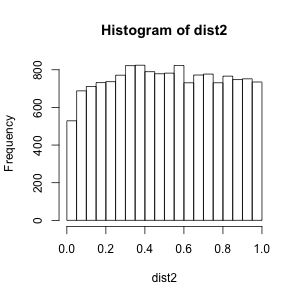With 15000 tests, you should indeed have a proportion of rejection close to the nominal error rate and a relatively clean histogram/density plot. If the error level is 1%, 3500 false rejections of the null is definitely a surprising result. My first guess would be that successive replicates are not as independent as you thought. I would therefore first try to split each set of 6 observations randomly to assess that.
Also inspect some of these p-values and look at a stripchart or a density plot, just to make sure the histogram is not misleading you and your code is fine. You can also try simulated data, again to make sure everything else in your procedure is working as intended.
One thing you did not specify is the nature of the data and the specific test you are using. With only 3 observations in each group, the sampling distribution of some test statistics (e.g. rank-based tests) can be very unusual (but usually not in the way you describe, I would think).
Just a quick illustration of what I mean, with a simulation (the code is in R).
set.seed(4123412) # Makes the whole thing reproducible
# Some test with 3 observations, null hypothesis is true by construction
rndtest1 <- function() {
t.test(rnorm(3), rnorm(3))$p.value
}
First, a simulation with 50 tests in total:
dist1 <- replicate(50, rndtest1())
hist(dist1)

As you see, the histogram is quite bumpy because with 50 observations you only have a rough idea of the distribution (or anything else, really).
Now, a simulation with 15000 tests:
dist2 <- replicate(15000, rndtest1())
hist(dist2)

Here the histogram looks almost the way you want it to look like under the null, i.e. like a uniform distribution.
(There is however a little quirk on the left hand of the plot. Indeed, the test is a little conservative:
> sum(dist2 < .05)/15000
[1] 0.03526667
> sum(dist2 < .01)/15000
[1] 0.006133333
It's an artifact of the small sample size and correction for unequal variances. Without the latter the histogram would be flat, an issue unrelated to the point I am making.)
Finally, my other point, a simulation with a test behaving differently with very small samples:
rndtest2 <- function() {
wilcox.test(rnorm(3), rnorm(3))$p.value
}
dist3 <- replicate(15000, rndtest2())
hist(dist3)

In fact, the p-value distribution is discrete:
> xtabs(~dist3)
dist3
0.1 0.2 0.4 0.7 1
985 989 1976 3039 3011
and therefore can never, ever, reject the null hypothesis at the 5% error level. This is why more information on what the data and test exactly are could be useful to spot other problems but in any case, 15000 tests should be enough to get a good idea of the p-value distribution and, hopefully, get uniform-looking data under the null.



